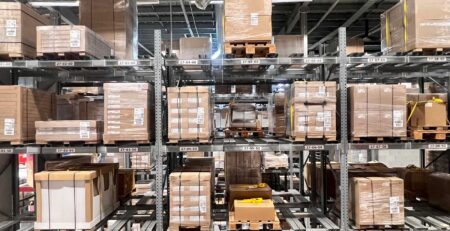If you’ve ever tried to move goods across state lines in Australia, you already know it’s not as simple as dropping something in the post. The more you understand how freight works, the less likely you are to waste time, money, or lose customers waiting on a truck that’s stuck in traffic or bad weather.
Interstate freight transport means moving goods from one state to another. It’s different from your regular local delivery because you’re now crossing borders, which brings in a few extra layers of complexity.
The sheer size of Australia, paired with unpredictable road conditions and long travel routes, means interstate delivery comes with its own set of rules.
For one, you’re dealing with multi-state compliance. That means different regulations, different rules on what can or can’t be transported, and often more paperwork. You’re also often handling freight between multiple depots or carriers, especially when it’s not a direct route.
On top of that, the travel distances in domestic freight in Australia are no joke. What looks like a short line on a map might actually be a 3-day drive. That’s why freight delivery times in Australia vary so much depending on the route and the mode of transport you choose.
How Long Does Interstate Freight Transport Actually Take?
If you’re sending something via domestic freight in Australia by road, the time it takes depends on where it’s going. Major city-to-city routes tend to be faster because they’re well serviced, have direct highway access, and have high transport volumes. Here’s a rough idea of how long it usually takes when road transport is involved:
- Sydney to Melbourne or Brisbane: 1-2 days
- Sydney to Perth: 4-6 days
- Melbourne to Adelaide: 1-2 days
- Brisbane to Perth: 4-6 days
These are standard timelines if nothing goes wrong. But remember, these are estimates, not promises. External factors including traffic, weather, and load type can change everything, any day. Further, the mode of transport you choose is also a major factor at play – here’s how.
- Road freight is the most flexible. It’s fast & cost-effective for several routes, especially from regions like NSW, where trucks are frequently used for freight forwarding.
- Air freight is an exceptional choice for ease and speed. You’ll most likely get next-day delivery, but it often comes with a hefty price tag. Makes a great fit for critical documents or high-value items.
- Rail freight is cheaper for big, heavy loads over long distances, but it’s slower and not ideal for last-minute deliveries.
- Sea freight exists for domestic shipping, but it’s almost never used unless you’ve got an oversized load and lots of time to spare. Most oversized load trucking companies prefer road-based solutions.
What Factors Slow Freight Down?
Even the most reliable systems get delayed sometimes. Here’s why freight might take longer than expected:
Distance and Destination
The further the freight, the more things can happen. Also, delivering to a city is different from delivering to a rural town. For example, freight delivery times in Australia are quicker for Sydney-to-Melbourne than they are for Sydney-to-outback Queensland.
Regional and remote deliveries almost always take longer because there are fewer routes, limited carriers, and harder-to-access roads.
Type of Load
If you’re sending something oversized, fragile, or high-risk, expect extra planning. Oversize load trucking companies have to use special vehicles, get permits, and follow certain routes, especially across state borders.
Mode of Transport
Like we said earlier, your transport type changes everything. Air is fastest, road is flexible, rail is cheaper but slower, and sea is slowest of all. So your choice should match the urgency of your delivery.
Carrier Schedules
You might think your freight goes straight from A to B. But unless you pay for express service, your cargo probably shares truck space with other shipments.
This is called backloading. It saves money, but it’s slower because the driver might make multiple stops along the way. Express deliveries, on the other hand, go directly, but you’ll pay extra.
Must Read: How to Ensure Security in Freight Forwarding
The Usual Suspects Behind Freight Delays
These are the most common reasons for delays in domestic freight in Australia.
- Bad weather and road closures: Bushfires, floods, and major storms are more than just headlines. They can shut down highways, especially on long routes like Sydney to Perth. The National Heavy Vehicle Regulator regularly posts updates on road conditions that can affect large freight movements.
- Peak season congestion: Around Christmas, EOFY, or major sales periods, every carrier is stretched thin. Freight delays are almost expected during these times.
- Wrong or missing paperwork: Something as simple as missing a label or not listing the right delivery contact can push your shipment back a day or more.
- Driver availability: The staffing gaps that hampered operations during COVID‑19 can still arise, particularly in remote regions or when flu season peaks.
- Restricted delivery access: Drops in CBDs with tight loading windows or narrow streets (for example, parts of Western and inner Sydney) require advance coordination; otherwise, a truck may not be able to reach the final address.
How to Minimise Delays Like a Pro
Avoiding delays in interstate freight transport is about planning, choosing the right service, and doing your part right from the start. Here’s what helps:
- Add a little buffer time to your delivery schedule, especially if it’s heading far or to a remote location. Even if the estimated delivery time says 2 days, don’t promise your customer until day 3.
- Choose your transport mode based on urgency. Use air freight for critical items, but road or rail for regular stock. Don’t use backloading if you’re on a tight deadline.
- Triple-check your paperwork. Make sure labels, addresses, and consignment numbers are correct. Every box should be clearly labelled, and your contact details must be correct.
- Use a provider that offers live tracking and proactive support.
- Pack your goods properly. Damaged cargo is not only a cost risk, but also a time risk, because damaged items might be returned or held.
Need Accurate Delivery Timelines? Ontime Freight Can Help
If you’re managing freight across New South Wales or anywhere else in Australia, don’t treat interstate freight like local delivery because it’s not the same game.
At On Time Freight, we understand how complex interstate freight transport can be because we do it every day. Whether you’re shipping from Western Sydney to Perth or anywhere else across Australia, our team will help you choose the right transport type, manage paperwork, and track your delivery every step of the way.
Need fast delivery? Special handling? Reliable updates without chasing? We’ve got it all covered for you.When it comes to interstate freight, the smartest move is working with people who’ve done it all before and do it well. If you’re not sure how long your shipment will take, or what kind of transport makes the most sense for your goods, reach out to us today and request a free quote!







